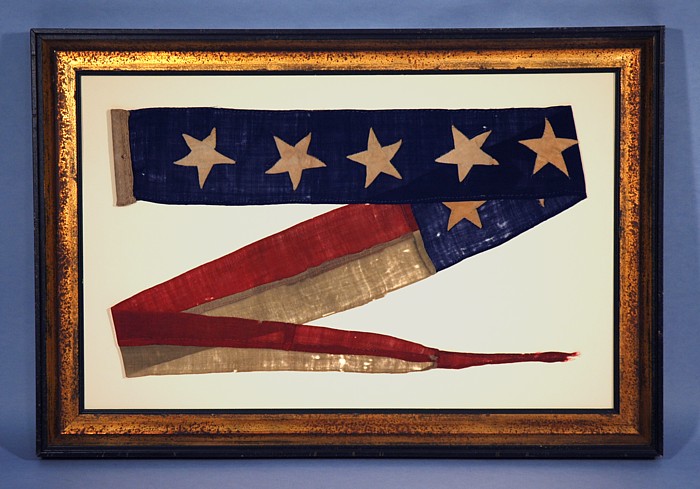
| |
HAND-SEWN, U.S. NAVY COMMISSIONING PENNANT, 1845-1865 (MEXICAN CIVIL WAR) |
|
| Available: |
Sold |
| Frame Size (H x L): |
|
| Flag Size (H x L): |
|
|
| Description....: |
|
| HAND-SEWN, U.S. NAVY COMMISSIONING PENNANT,
CIRCA 1845-1865 (MEXICAN WAR CIVIL WAR):
Commissioning pennants are the distinguishing mark of a commissioned U.S. Navy ship. In the 19th century and prior, it was often difficult to distinguish between the naval and merchant vessels of most nations, so long streamers like this, flown at the masthead, served as a primary means of communicating the disposition of a ship. A navy ship became commissioned when this pennant was hoisted, and the commissioning pennant is flown at all times, during both peace and war.
This particular pennant probably dates to the Civil War (1861-65), but may date a bit earlier. The construction is entirely hand-sewn of wool bunting, with cotton stars and a heavy, sailcloth hoist. The rather crude stitching suggests that it was likely made at sea, or, at the very least, re-made by a sailor from a larger pennant. The longevity of flags in regular use at sea is very short. Even with modern fabrics and construction, most flags of today only have an expected lifespan of six months.
Hand-sewn, 19th century commissioning pennants are extremely scarce and I have seldom had the opportunity to acquire one. Most early examples were considerably larger than this one. By 1870, for example, the largest in use was 70 feet long. Since smaller examples are much easier to display, they are more greatly desired. The earliest pennants had 13 stars, commemorating the 13 original colonies. Much smaller, 7 star pennants were introduced for smaller Navy boats, such as captains gigs. They were also flown from the earliest submarines and destroyers. The reason behind the use of this star count is unclear. Some have suggested that it could represent the seven seas. Others site both biblical and other religious reference to the importance of the number seven, and since sailors were notoriously superstitious, this is certainly a educated guess. But it may just as well have been an accommodating number for a smaller design, and no known record exists to establish fact. With regard to the Stars & Stripes, the Navy flew mostly 13 star flags on small boats until 1916. But they also flew 16-star and 20-star examples. The commemorative purpose of 13 stars is clear, but as with the 7-star pennants (which are still in use today), no record exists of the executive decision to use 16 and 20 star flags. Although theories have been formulated, the real reason may just as well have been a matter of convenience. 4 rows of 4 stars, for example, are easily accommodated on a small flag.
Mounting: The pennant has been hand-stitched to a 100% cotton rag mat and placed in a black painted, hand-gilded, and distressed Italian molding. Spacers keep the textile away from the glass, which is u.v. protective. |
|
|
|
| Collector Level: |
Advanced Collectors and the Person with Everything |
|
| Flag Type: |
Sewn flag |
|
| Star Count: |
7 |
|
| Earliest Date of Origin: |
1845 |
|
| Latest Date of Origin: |
1865 |
|
| State/Affiliation: |
Other |
|
| War Association: |
1861-1865 Civil War |
|
| Price: |
No |
|
| |
Views: 4438 |
|
|
|

